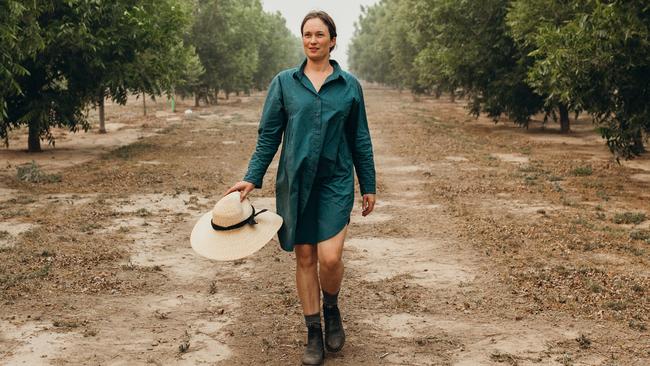Take me home, country roads
Cheap houses, growing jobs, a fabulous lifestyle: in the regions, people live where they love to be.

Australia’s regional agriculture and resources heartlands have continued to grow amid this year’s national economic downturn, as country leaders hope the unprecedented shock will make more city dwellers consider a move.
Regional economies — dominated by domestic food production, energy and mining — have added more than 20,000 new positions in June and July since May, more than the jobs added in the cities.
Advocates want to highlight the benefits of being out of the capitals, pointing to the lower-density living, availability of larger and cheaper homes, skilled-job availability, and people’s sudden awareness that they can work remotely.
Regional Australia Institute chief economist Dr Kim Houghton says some regions are performing well, but the impact of the COVID-19 health crisis and restrictions is highly varied across the country.
“Those places that are based in mining and agriculture, they’ve got those supply chains and they haven’t been buffeted as much as other places, they really are very well placed to provide a major contribution (to future growth),” he says.
“There are the haves and the have-nots.”

He points to other rural areas, such as southern NSW and eastern Victoria, facing deep and sustained economic declines after this year’s twin disasters of bushfires and COVID-19.
The differences in local economies are stark. Around global tourism destinations such as Byron Bay, Margaret River and Apollo Bay, more than 60 per cent of local businesses are registered for JobKeeper — meaning their revenues declined at least 30 per cent.
Using the most recent gross domestic product figures available, consultancy SGS Economics and Planning highlights the patchwork economy of Australia’s regional areas.
For the financial year to June, parts of rural Western Australia, South Australia and central Queensland were tipped to grow up to 2.5 per cent, against a national fall of 6.7 per cent gross domestic product.
But declines of 15 per cent GDP and more were predicted for regions heavily dependent on tourism such as in coastal regions, Cairns in Queensland and SA’s Kangaroo Island.
This preceded this month’s COVID-19 outbreaks and stage four restrictions in Victoria, which are expected to reduce the state’s economy more than $10bn and create severe job losses in the regions.
As Australia determines how best to emerge from its pandemic-crisis response to a recovery phase, Australia’s regional leaders say they may be best placed to anchor it.
They say there is space, opportunity and jobs, as well as reducing the inherent risk of urban density, with about two in every five Australians living in Sydney and Melbourne.
Bendigo and Adelaide Bank managing director Marnie Baker — who lives in the Victorian city of Bendigo and has led the Business Council of Australia’s regional economic task force — says the pandemic has “opened people’s eyes” to the advantages of living and working in the regions.
“We have always talked about the lifestyle being fantastic in the regions and housing being more affordable, especially for young families,” she says.
“Employment had seemed to be a bit of barrier in the sense you needed to live physically close to the office, but now COVID has shown us that you can work from anywhere.
“You can live where you love instead of where you work. It has changed the paradigm.”
The trend to get out of the city was already starting to emerge.

After significant population declines from the 1970s to the 1990s, sea-changers boosted coastal towns in the 1990s. Targeted immigration and growth in some regional centres also fuelled growth in discrete regional areas at the start of the new millennium.
Between 2011 and 2016, 65,204 more people moved out of Australia’s cities than regional people moved to the city.
With the mining-construction boom in full swing, more regional young people under 35 years moved to a different regional area rather than a city. And there were fewer young people who moved to Sydney than to the regions.
Publisher, photographer and podcaster Annabelle Hickson was one of those people to make the move to the regions in the 2000s.
The Sydney-born and raised journalist fell in love with a farmer, Ed, and moved from Brisbane out to Moree, then to a pecan farm 80km west of Tenterfield in the Dumaresq Valley of northern NSW.
‘COVID has shown us that you can work from anywhere’
Being out in the bush is partly inextricably linked to her creative output, which spans photography, the podcast Dispatch to a Friend, and her book, A Tree in the House.
She says being in the regions has given her the capacity for creativity.
“I feel at more of an advantage because I don’t have to pay crazy city rents, and when I’m in the city I just feel overwhelmed by so much going on and there is so much potential,” she says.
“I feel so much better at home. It has really allowed me to hone in and focus.”
And it has struck a chord. Her podcast, created in collaboration with Brisbane-based Gillian Bell, has been downloaded more than 140,000 times.
She says the country voice continues to retain its strong character and its appeal amid an increasingly globalised and homogenised urban world.
“We do have a quite distinctive sense of place,” she says. “It’s strong and it’s unique and it’s so beautiful.
“I think that is becoming more and more treasured as everything becomes increasingly the same. And that is something that is really important to me.”
There may be signs some city-dwellers are exploring their options now, or at least dreaming of a different life.
The chief economist for REA Group, Nerida Conisbee, says search activity for some regional areas is up.
She says this is particularly in Bangalow in northern NSW, Dural in the Hills district outside Sydney, and Glenbrook in the Blue Mountains, which made the top 10 search destinations list for NSW in the three months to June.
“In the four years we have been tracking this data, I have never seen locations outside of Sydney make the list,” she says.
In Victoria, Geelong continues to be a popular search, building on its nation-leading price growth over the past three years, according to listings supplied by the REA Group to The Australian.
It comes after regional areas filled eight out of the top 10 strongest-performing local government areas for house prices.
Launceston and the northeat of Tasmania recorded price rises of almost 30 per cent. Victoria’s high-growth regional towns Ballarat (24 per cent), Geelong (18 per cent) and Bendigo (17 per cent) were in the top six.
Conisbee says future population movements are “very unclear” amid the dramatic change in work for many Australians.
“If there is a permanent change to the way that we work and we don’t need to go into the office all the time, or at all, this means we are no longer so tied to being in a capital city,” she says.
“Regional areas offer a lot as they tend to be quieter, they are often more affordable, and there is often a strong community. The locations themselves can be particularly attractive. I would say this would push many people to these areas if they weren’t so tied to a capital city for employment.”
So what brings people to shift their lives and families to a new town? And why do only some towns survive?
Many factors have to line up for people to make the move, including the availability of jobs, good education options for their children and the attraction of a good lifestyle.
In recent years some regional cities within commuting distance to capitals have grown, underpinned by economic diversity and amenity.
These include NSW’s Griffith, Orange, Newcastle and Wollongong; Ballarat and Bendigo in Victoria; and Queensland’s Gold Coast and Sunshine Coast.
‘Regional areas offer a lot ... they are often more affordable, and there is a strong community’
University of Queensland demographer Dr Elin Charles-Edwards says there are pockets where regional centres are growing, but it is a complex picture.
“It’s really hard to know the determinants of intraregional migration because they’re multifaceted,” she says.
“You would expect people to move from areas of high unemployment to low employment, but it doesn’t always happen that way. Housing does have a role in it and it’s also tied up in where people are in their life course. It’s age-dependent: a lot of people return (to regional areas) in their 30s and 40s.”
She says areas that could benefit from a work-from-home shift are centres still within commuting distance of the cities.
“Working from home has been increasing over the past 20 years but it’s almost exclusively in the financial and professional industries, it’s not for tradies or teachers,” she says. “It’s a relatively small subset of the population that will take advantage of this.”
SGS Economics and Planning partner and national leader for economic and social analysis Terry Rawnsley says centres that have grown share attributes of natural beauty and enough perks of city life to attract urbanites, such as being able to get a good wine and coffee, and see an interesting exhibition or art show.
He points to the Bendigo Art Gallery’s recent Grace Kelly fashion international exhibition that skipped Sydney and Melbourne and went directly to the Victorian regional centre.
“That brings tourists in,” he says. “That’s the process for these places two hours from the capital city. “It’s those high-amenity locations, there is food, wine and culture, and the connection back into the big city so if you want to do the commute you can.
“People come out and they go, ‘This is actually a nice place, the coffee is good, I can get a good wine. I can sell my $1 million house in Melbourne and buy a cheaper and bigger house and pocket the difference’.”
He says some towns, however, may continue to decline.
The challenge is matching the jobs to the population.
As the COVID-19 pandemic impact continues, agricultural areas will face a challenging skills shortage for harvest and planting.
In the most recent quarterly figures from the ABS, the electricity, gas, water and waste industry increased its small employment 24 per cent, while agriculture, forestry and fishing also increased its workforce 9 per cent.
The mining industry lost workers, but it was one of the few industries where the number of hours worked increased.
The Regional Australia Institute’s Houghton says there are jobs out there. “There are good jobs in the regions, which I think has sort of gone under the radar,” he says.
Flavourtech in NSW’s Griffith is one of those innovative country companies searching for workers.
The advanced manufacturing company exports and services hi-tech machinery to create scent and flavour extraction and essences, used in food, drink and pharmaceutical manufacturing in 60 countries around the world.
Chair and general manager Leon Skaliotis says they are leading the world in their technology, highlighting that industry in the regions is “not just rocks and crops”.
But he says attracting the highly skilled workers they need is the biggest challenge they face.
“Being a hi-tech company, it is definitely a hard task to find somebody from regional Australia who has the engineering know-how to come and work for us,” he says.
“It takes about a year and a half to train someone up. That’s one of the reasons why we are such a multinational company — we have 23 different nationalities working for us.”
He says there are many benefits once workers are in the regional city, with a “five-minute” commute and a good lifestyle available, alongside wages comparable with Sydney or Melbourne.

As Australia searches for ways to claw back growth after the pandemic, some regional areas are focusing on drivers in key areas.
A Regional Australia Institute report, Regional Growth Prospects, highlights four business-led industries with significant potential to drive regional growth, noting international research shows business-led specialisation works to support regional competitiveness in a national and global context.
“This report shows that specialised regions have not performed equally over time, with local conditions in some regions helping to drive employment growth, while local conditions in others may be constraining it,” it says.
The pre-COVID report cites food processing, tourism, advanced manufacturing and creative industries as key sectors where regions can thrive.
Regional advocates are calling on big business to join them, to regionalise, diversify their risk and create local jobs. They want government incentives, such as payroll tax concessions or transport subsidies, to accelerate the move.
Asked about the call for incentives, Treasurer Josh Frydenberg said in a statement the Australian Government was “committed to supporting the growth of our regions into the future”.
About 14 per cent of the total Australian government public service is location in regional areas outside capital cities, a proportion that has increased since 2012.
Bendigo and Adelaide Bank’s Baker says regionalisation also creates strategic advantages for organisations.
She says just going to the supermarket or the local footy, everyone knows her, so she gets all the feedback. “You can never become disconnected to your customer base,” she says.
And she says the lifestyle is second to none. As the boss of Australia’s fifth-biggest bank, she lives on a small farm and has to cross two traffic lights to get to work.
“I would absolutely encourage people to consider the benefits of living and working in regional Australia,” she says. “I’m an example of the benefit you get from living and working in a regional centre. Being able to operate a business in a regional city or centre is a bit of a secret ingredient of ours, but I don’t want to keep that a secret. Others should look to how they can move their own businesses and set up in regional Australia.
“If regional Australia is humming, the whole economy will be humming. It plays a huge part and will play a huge part in the recovery of Australia.”



